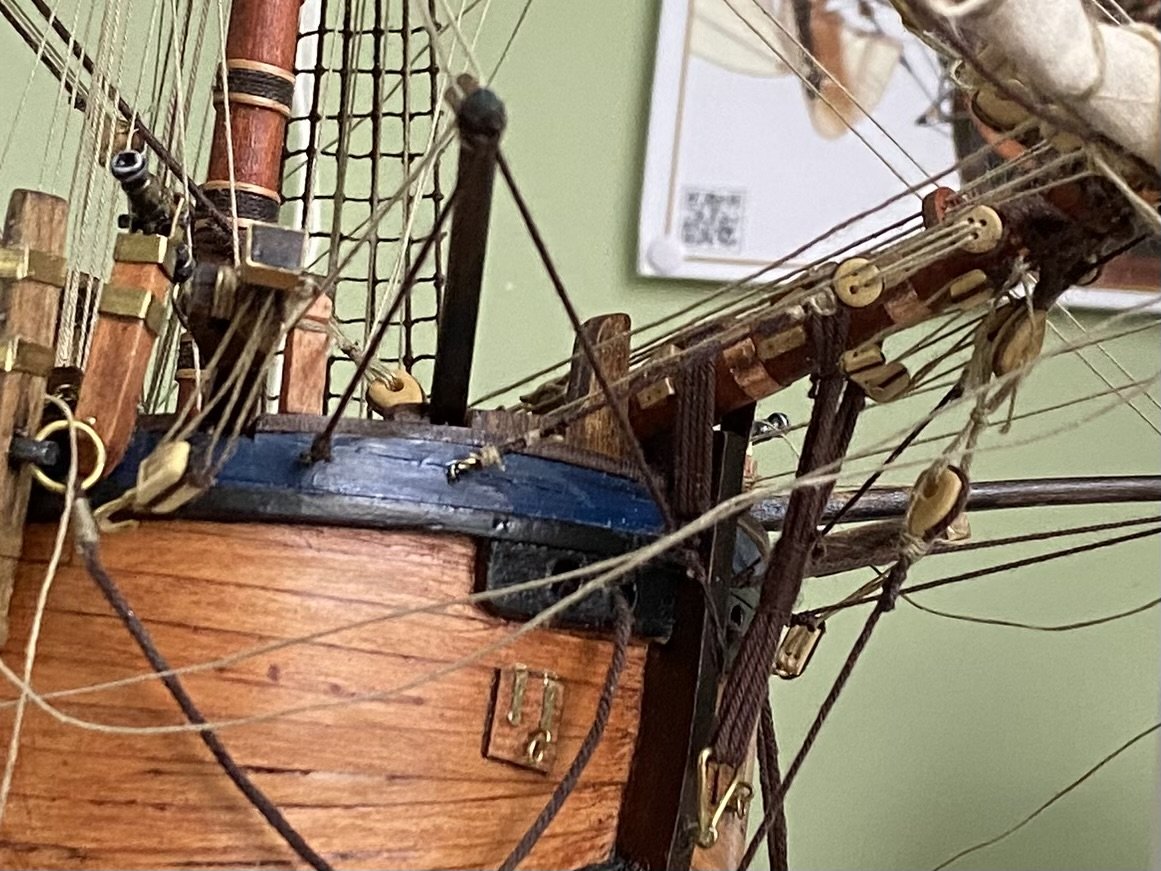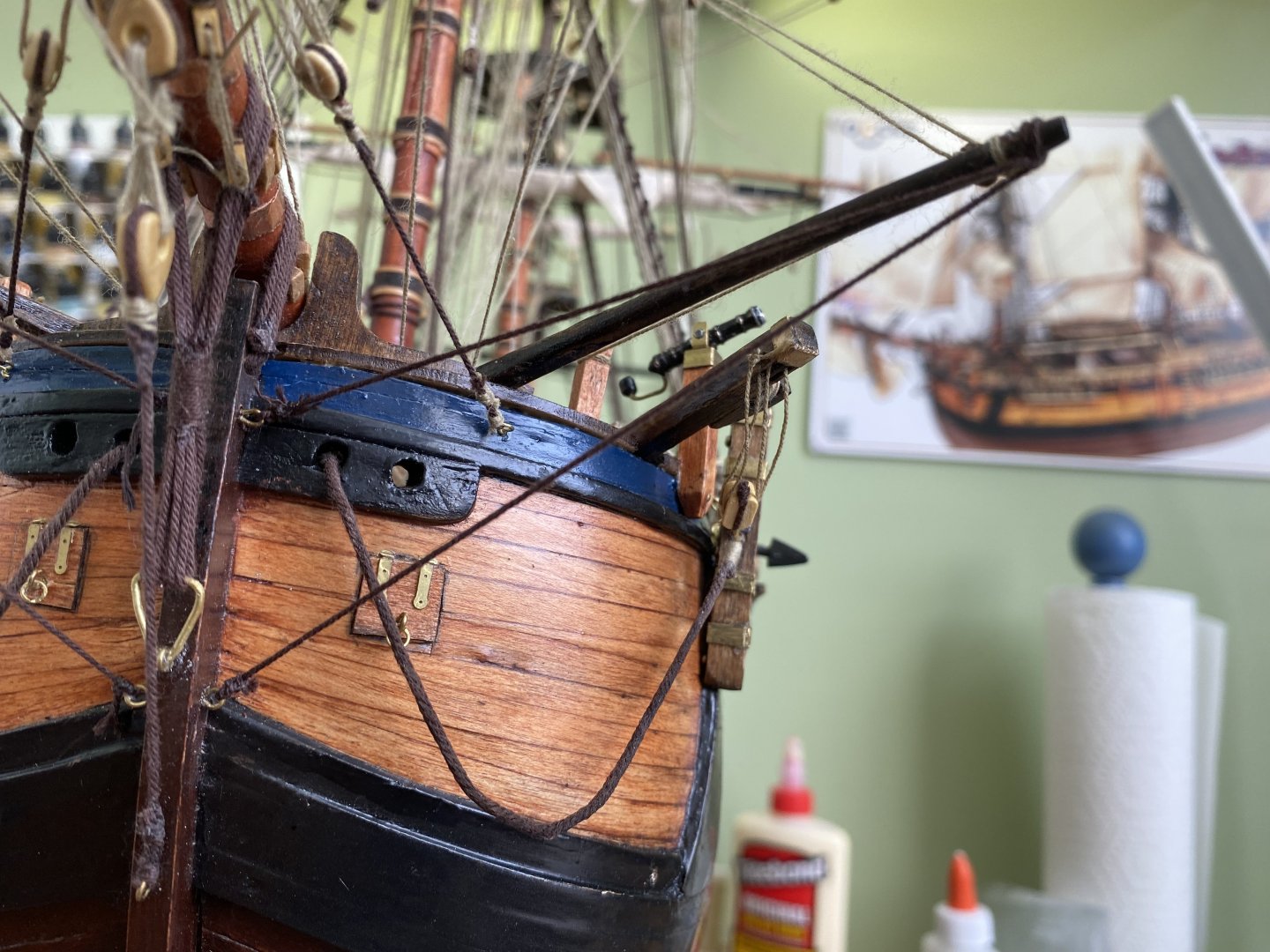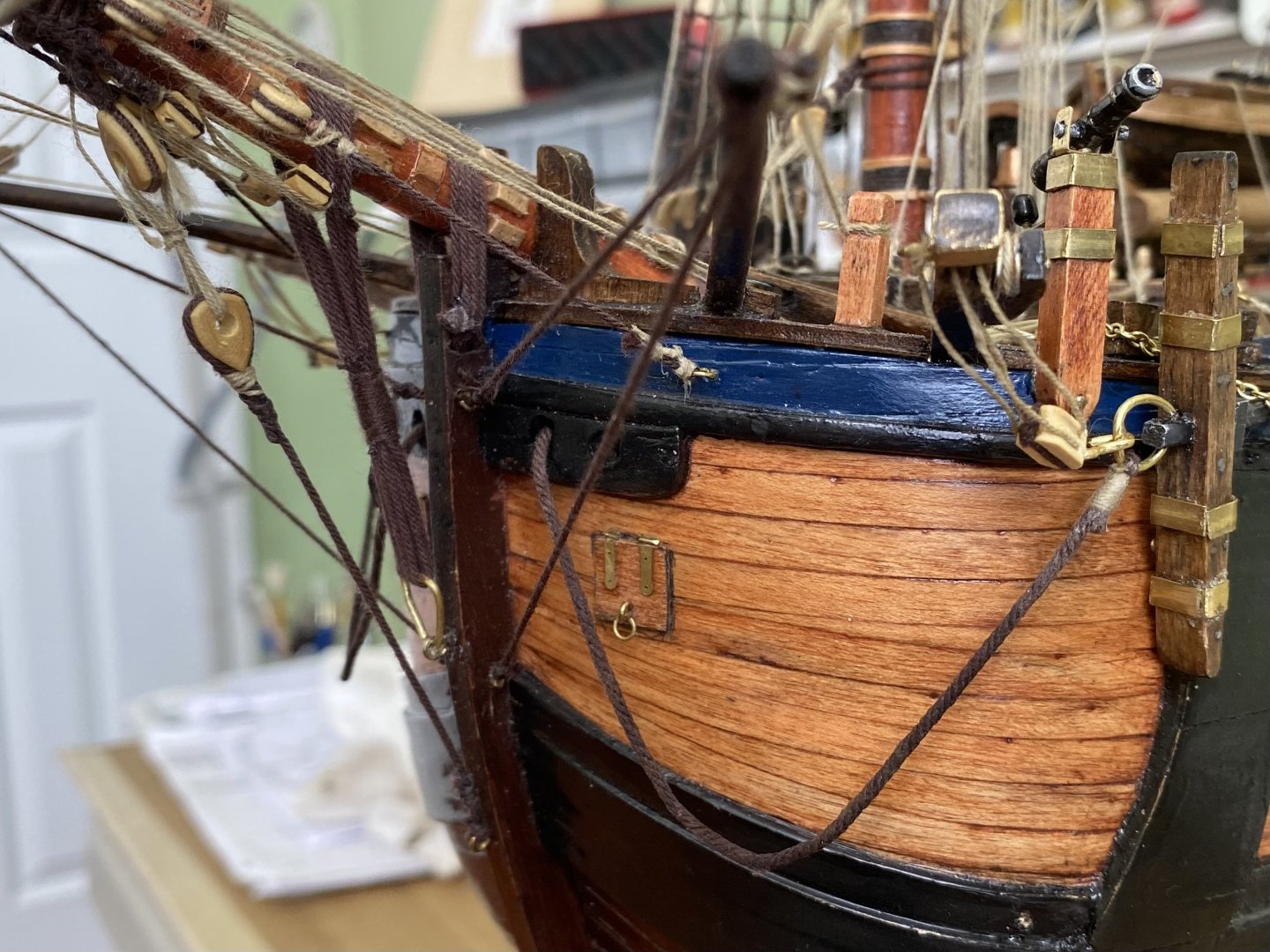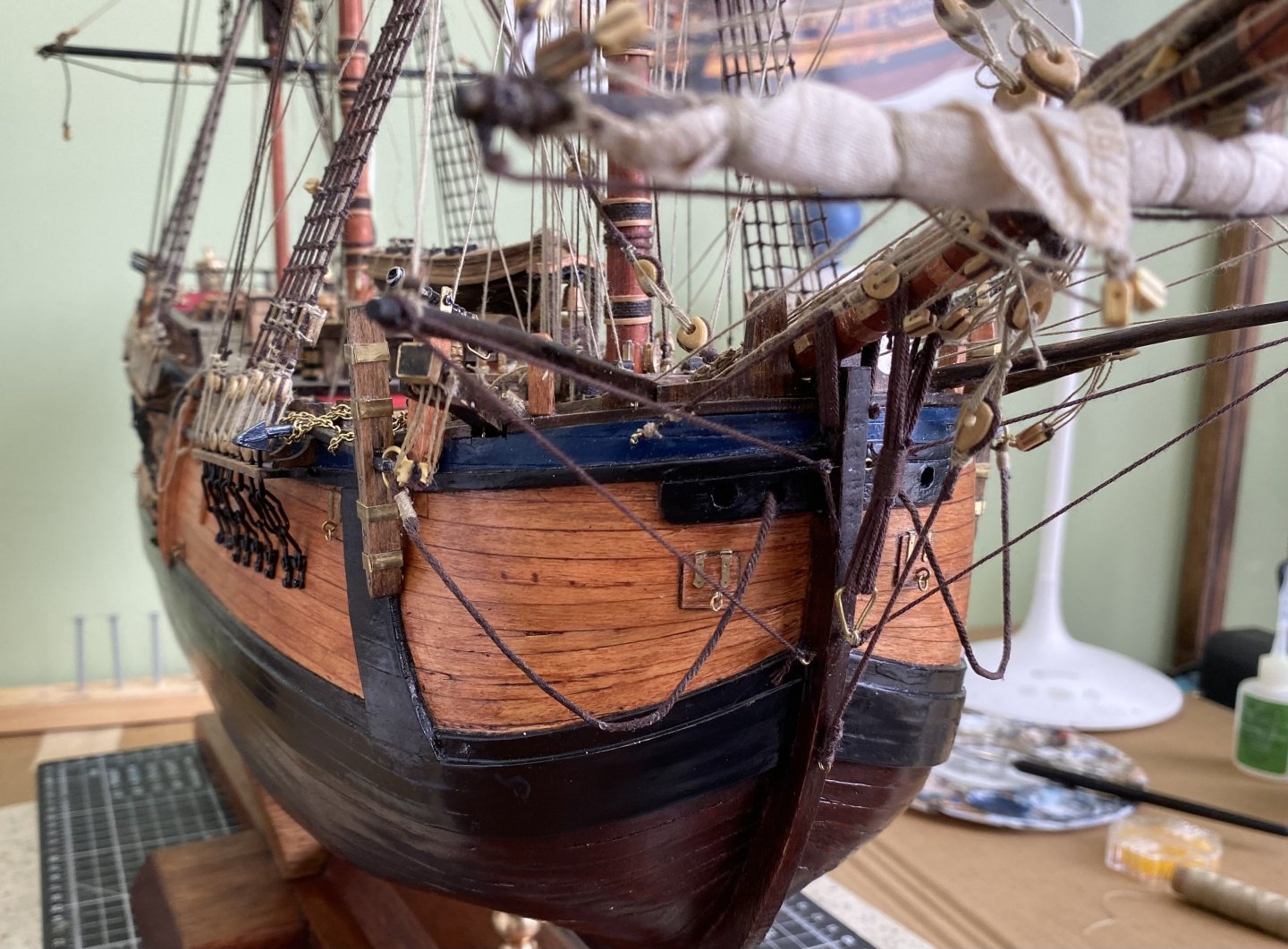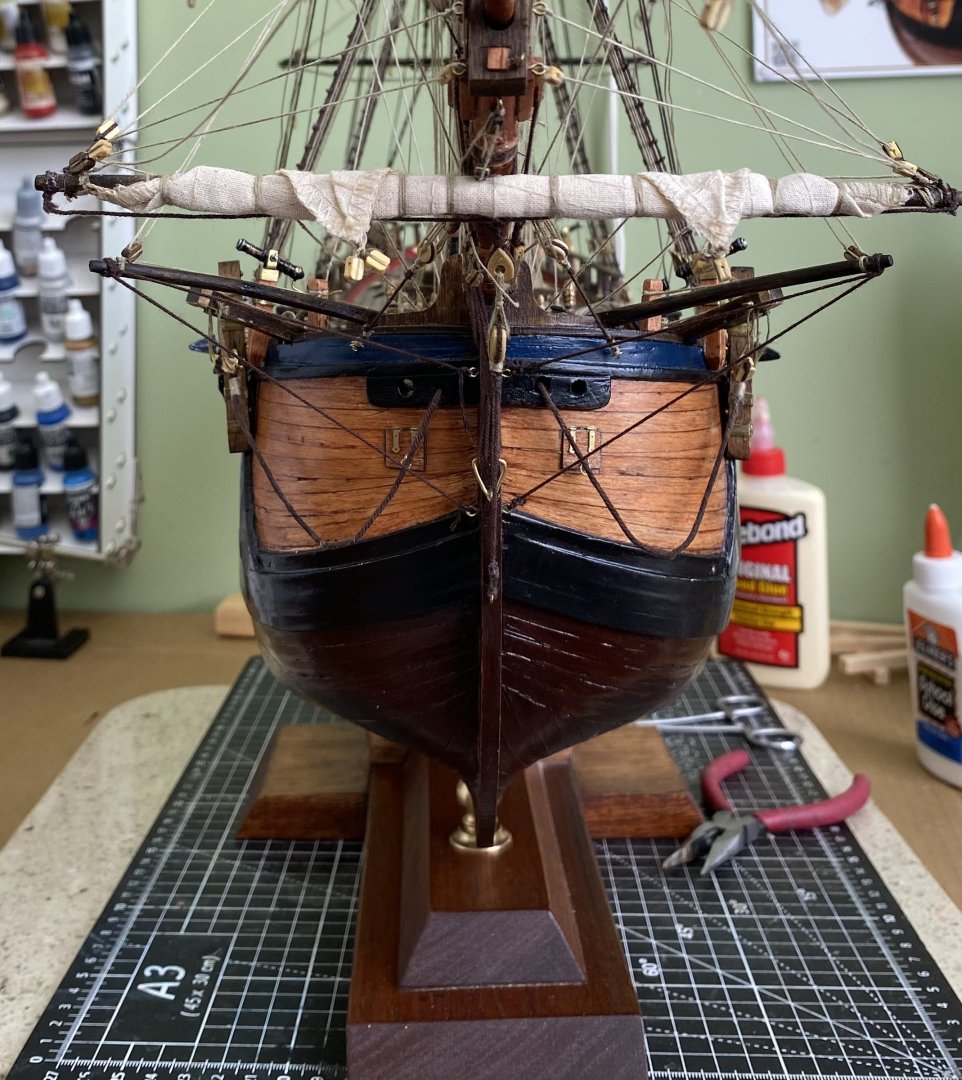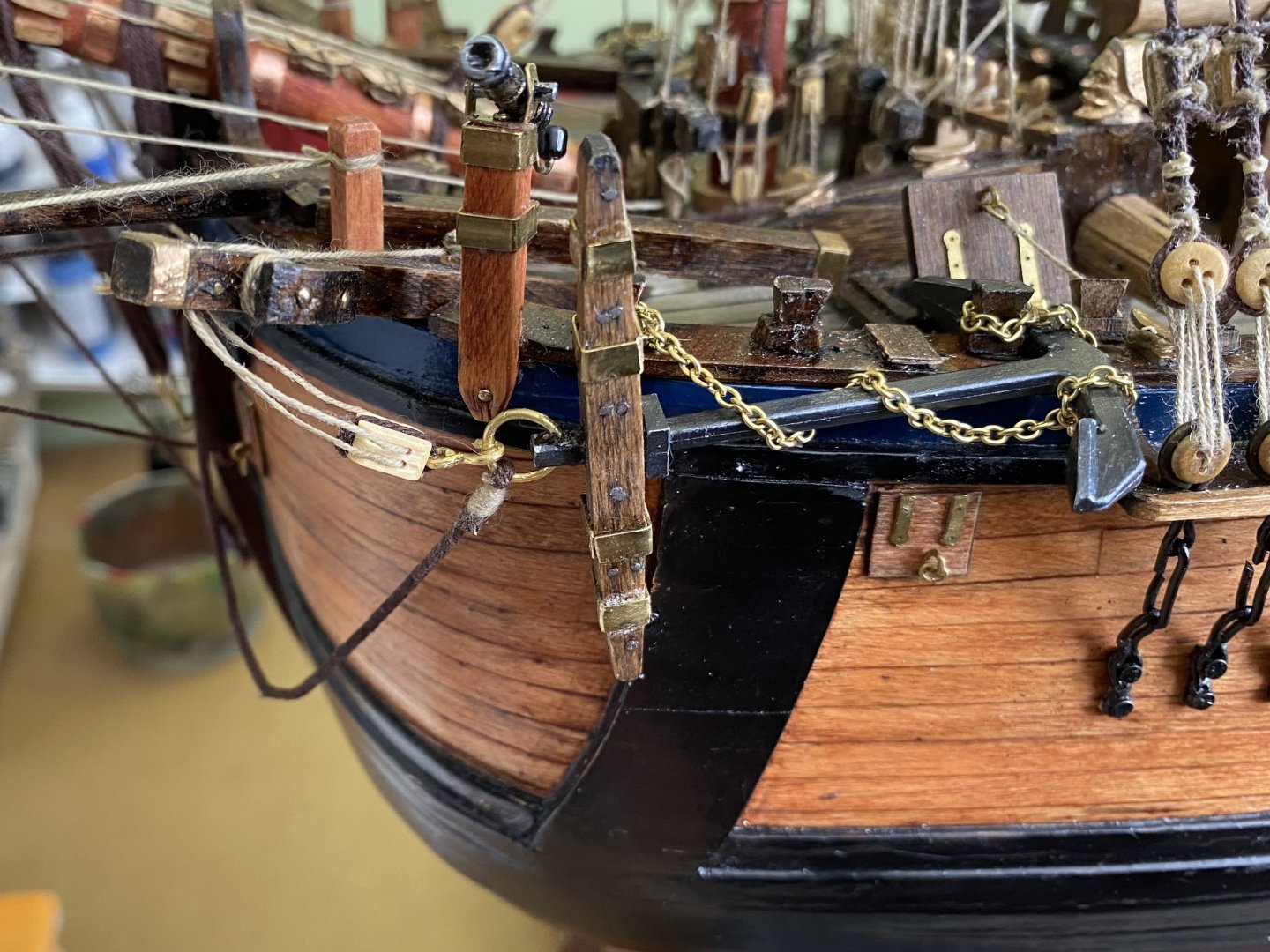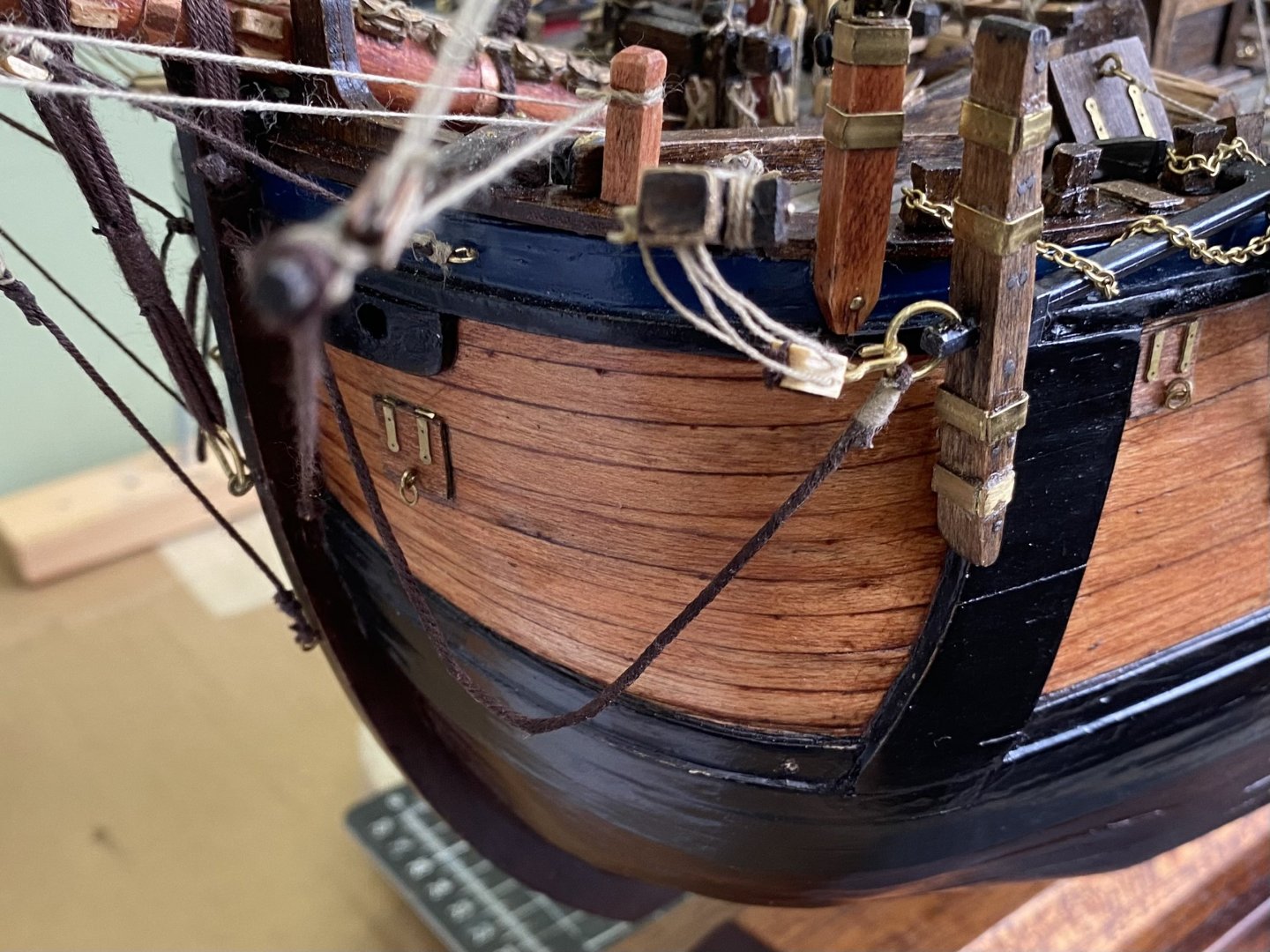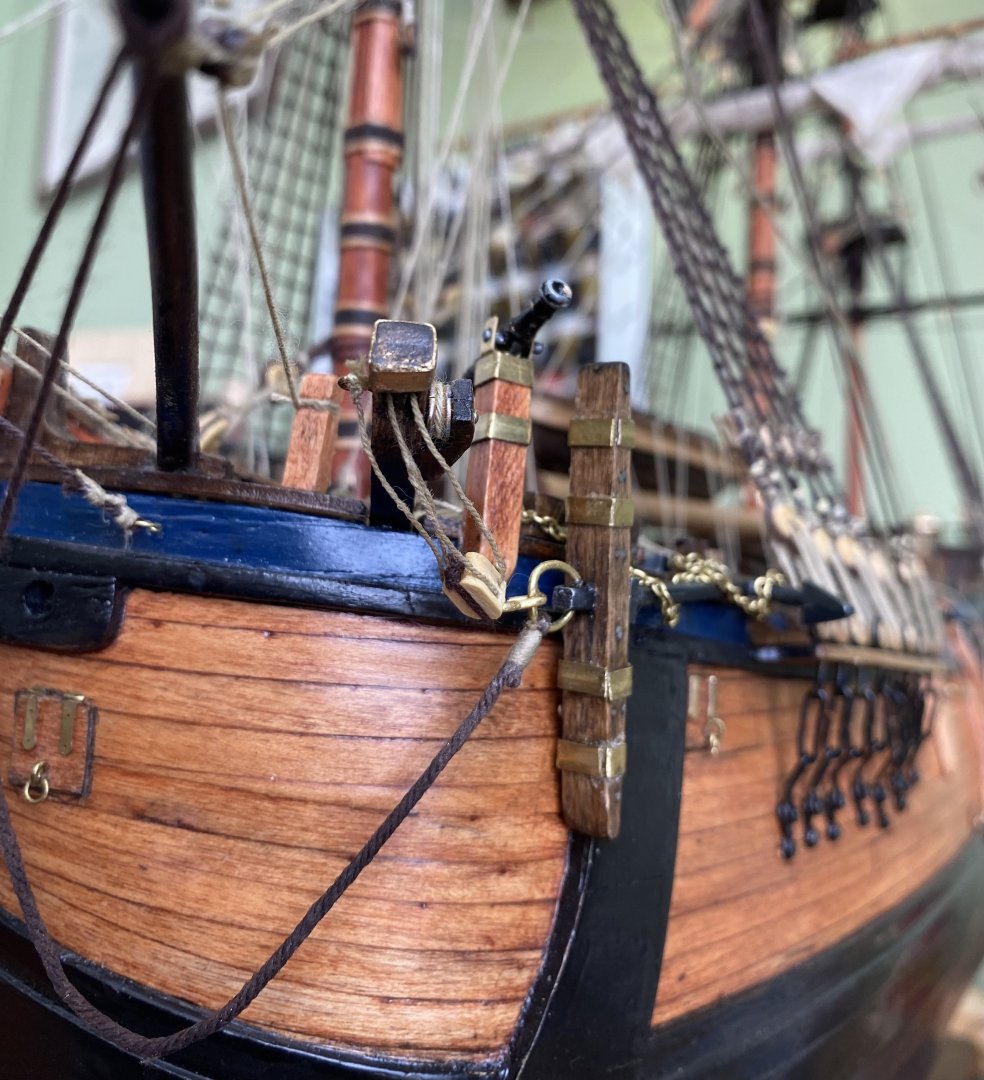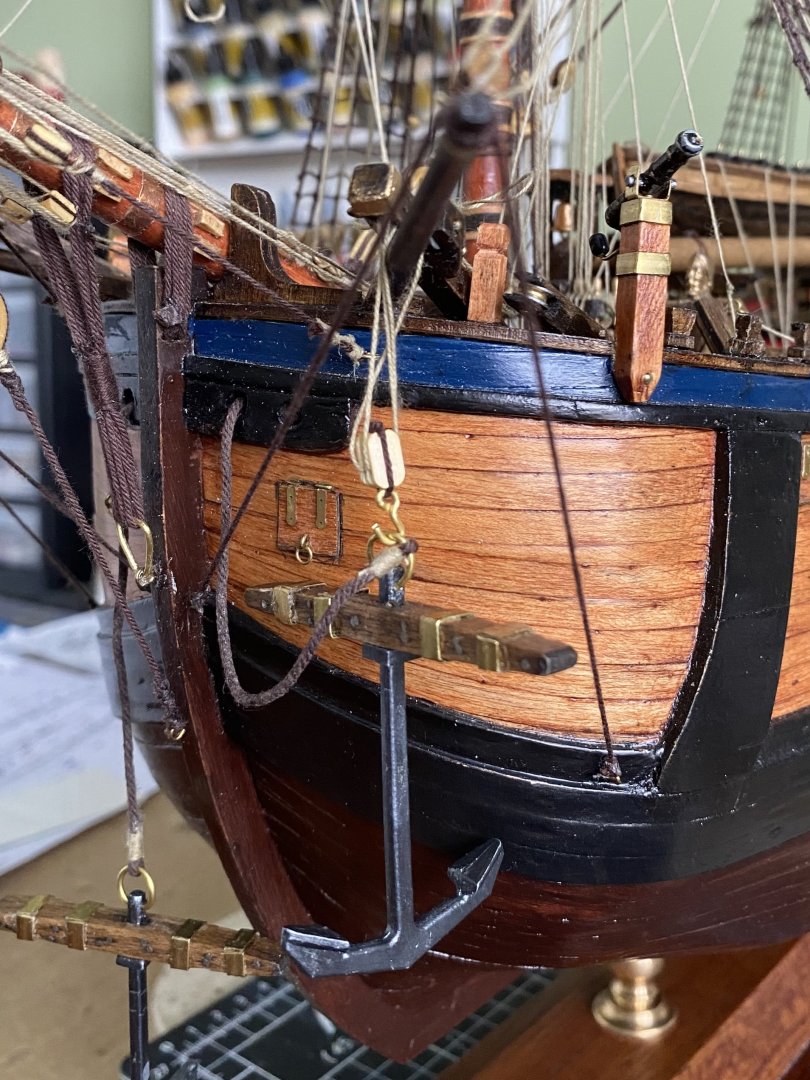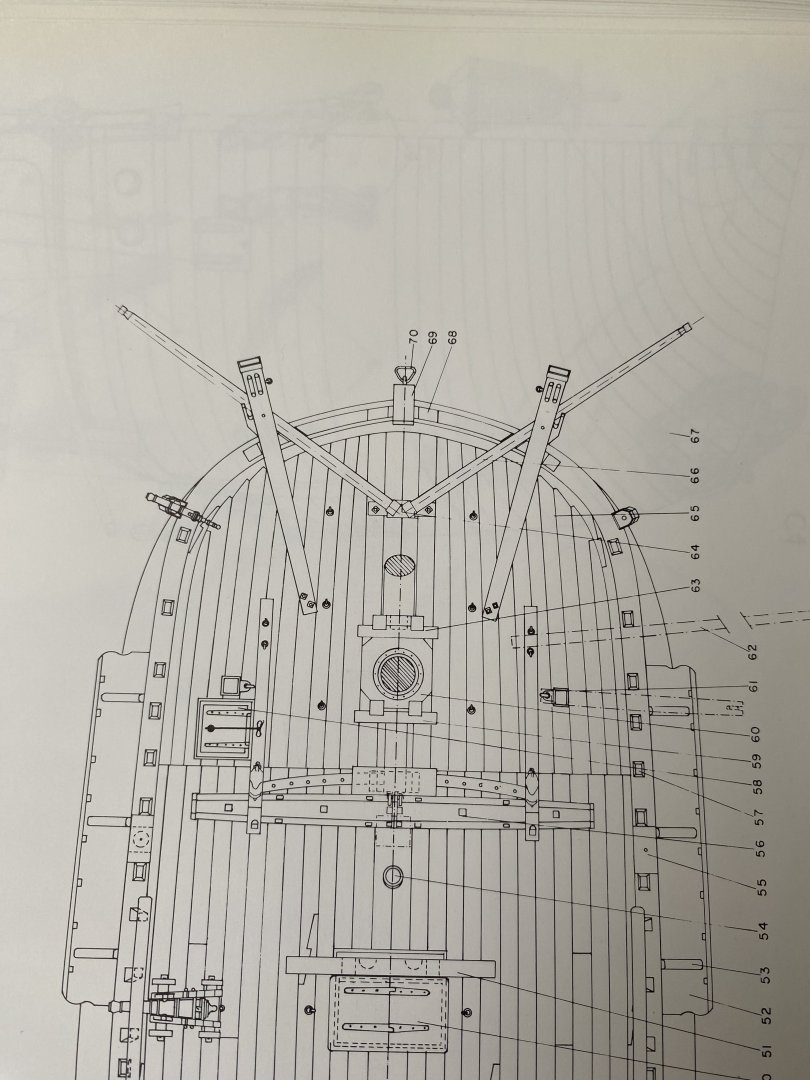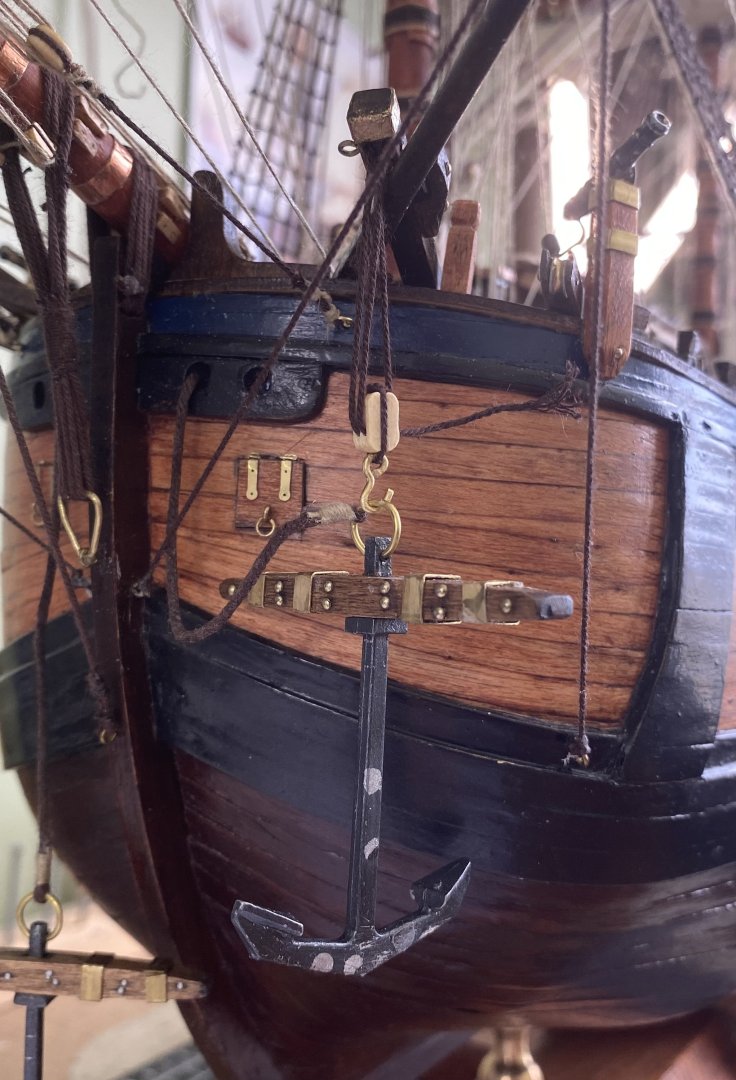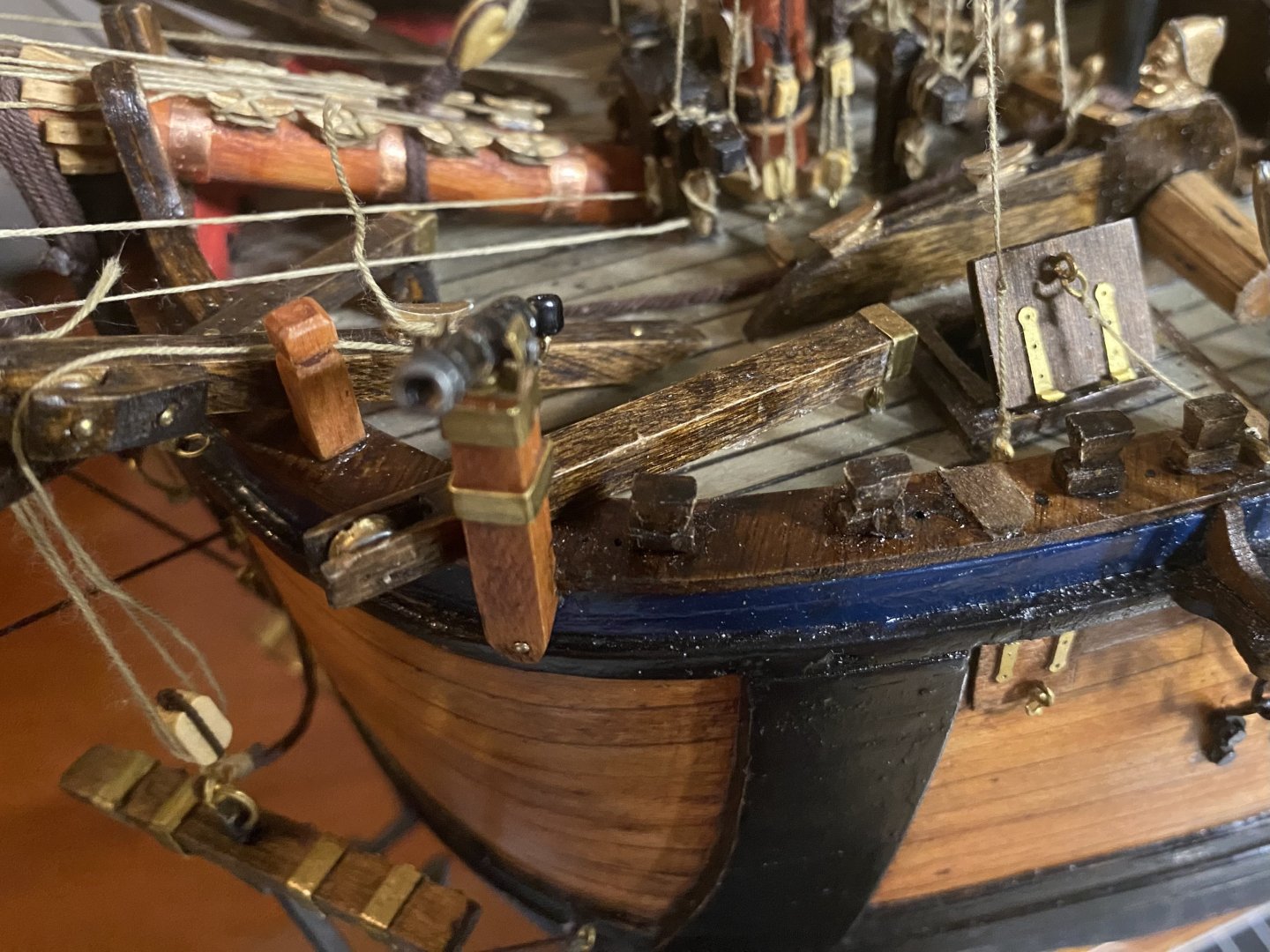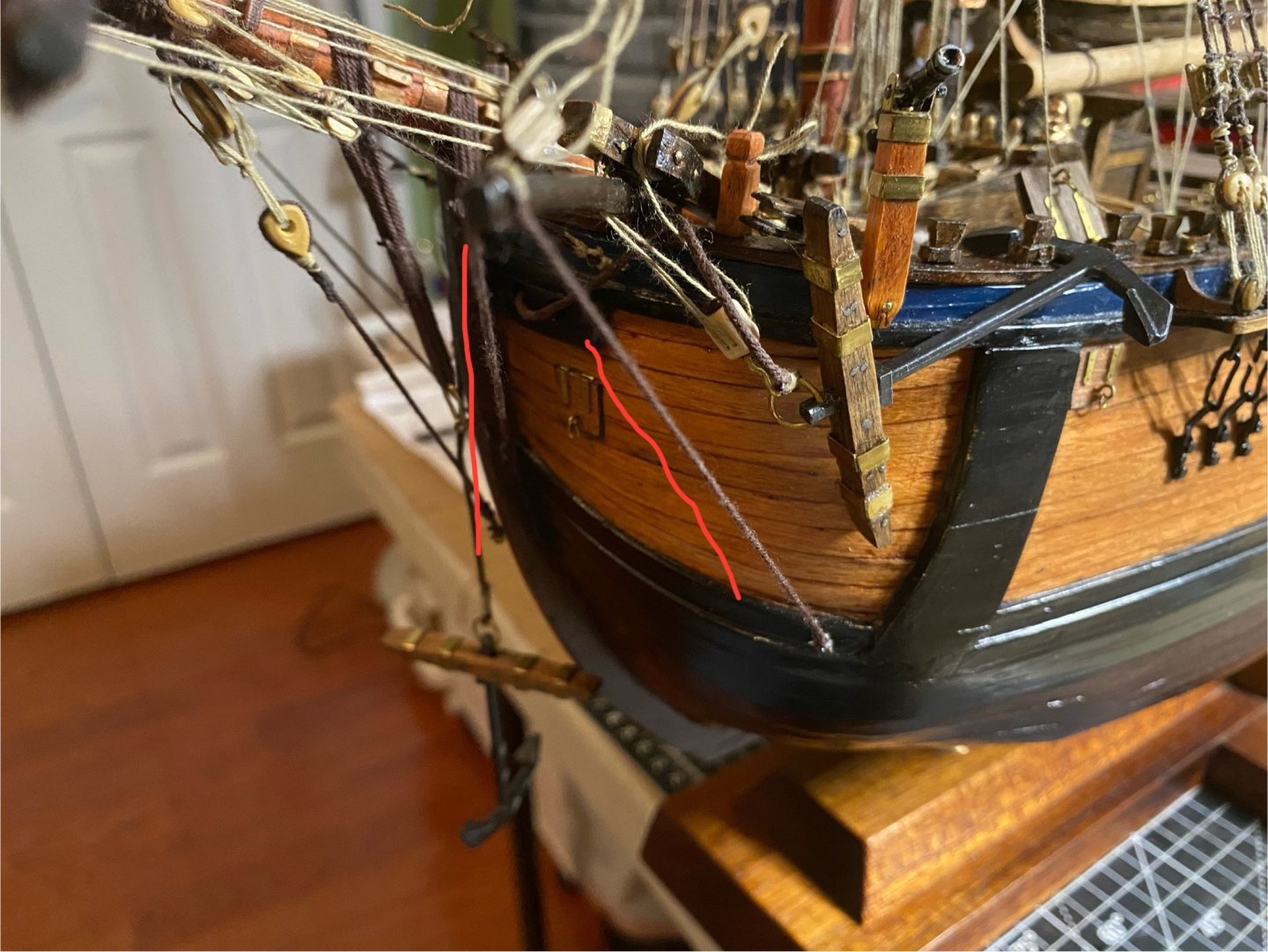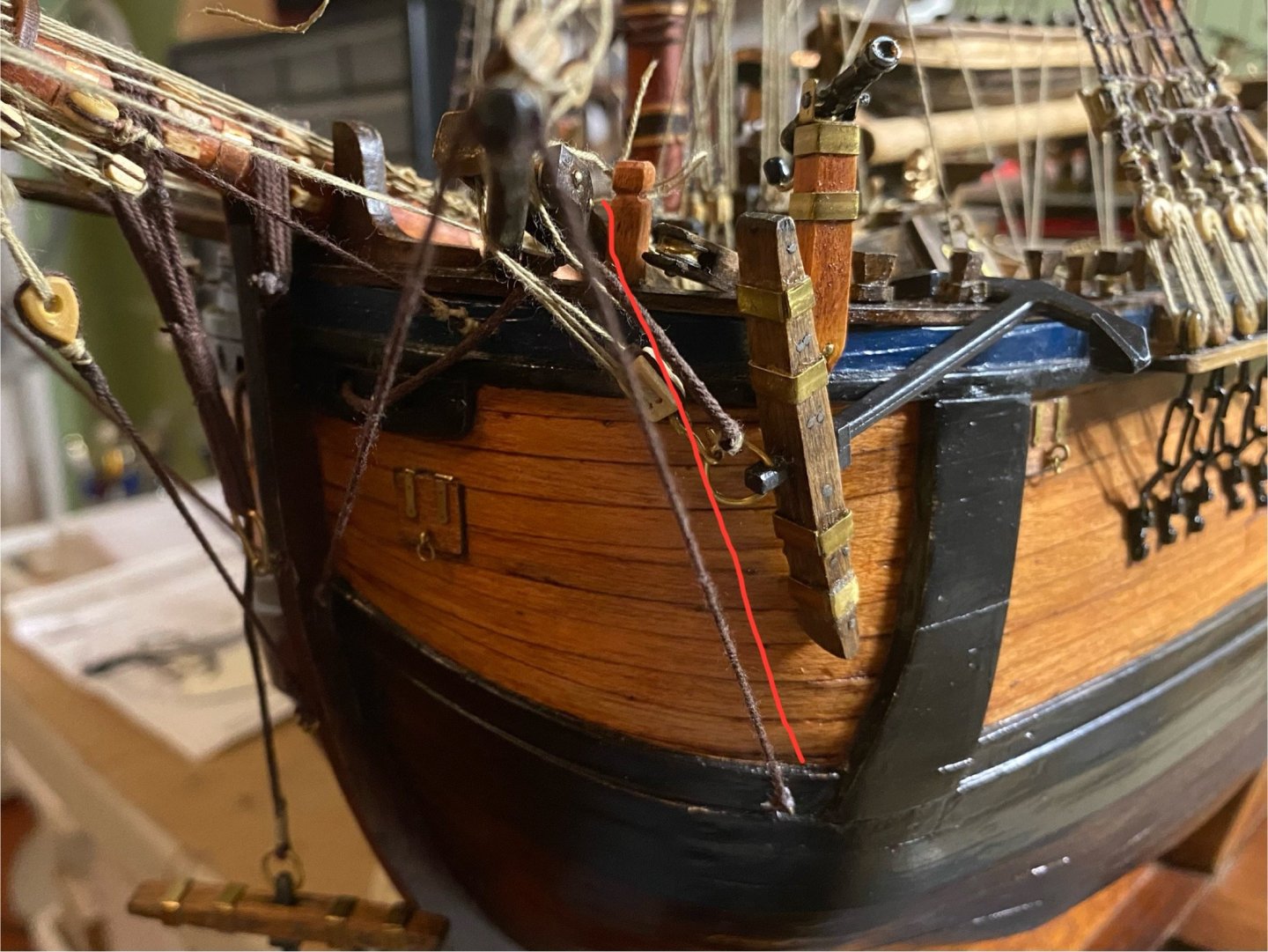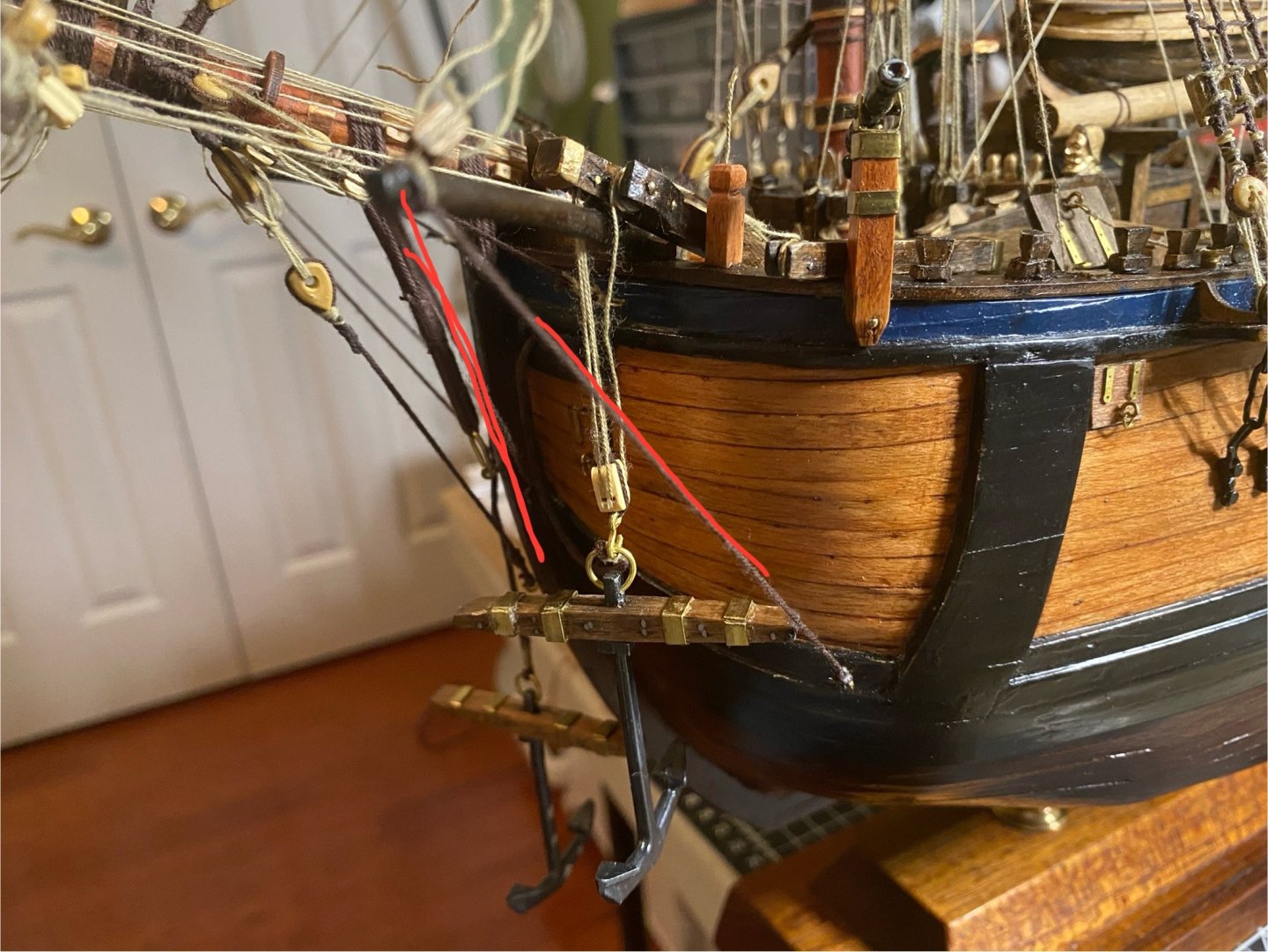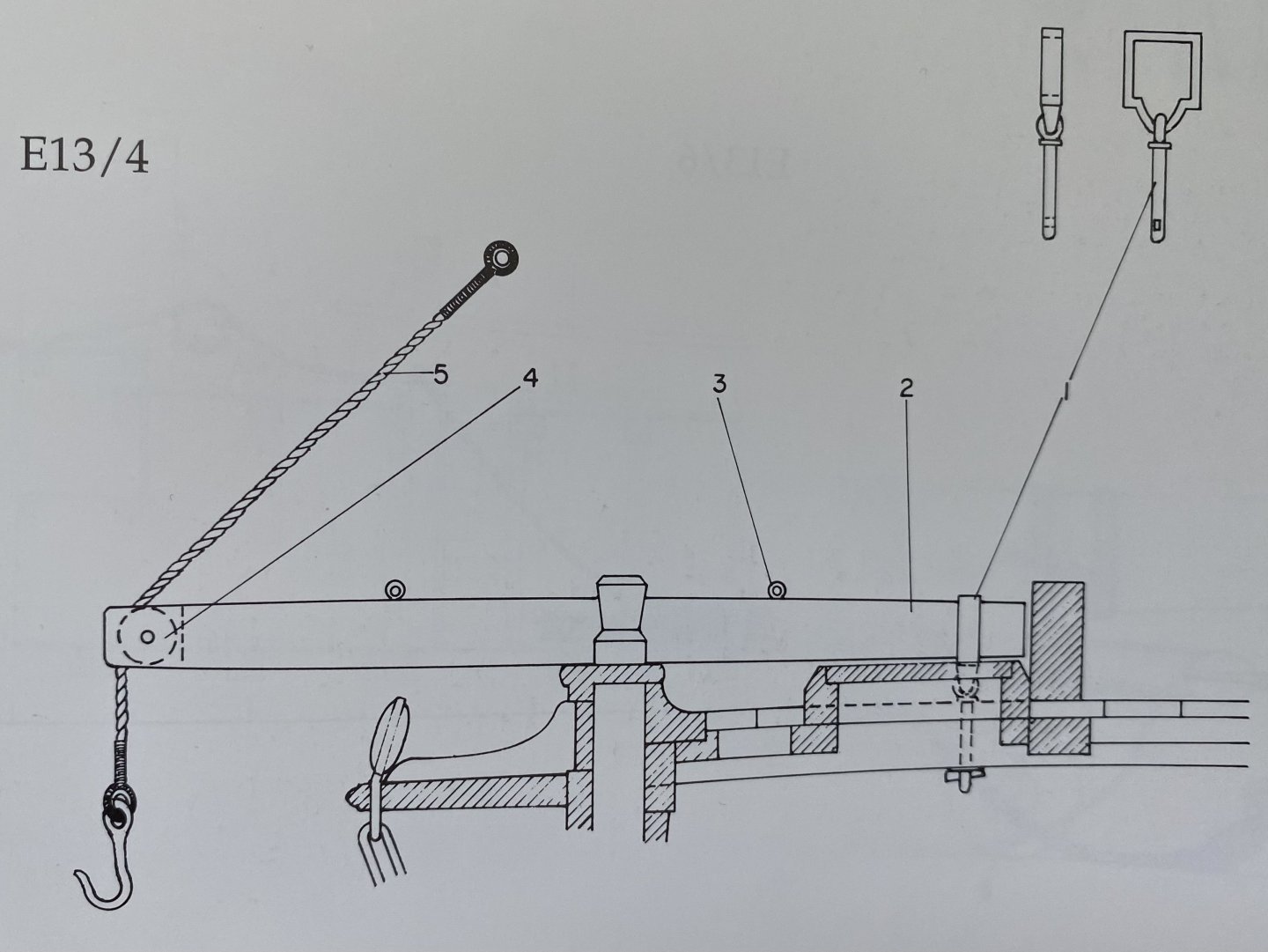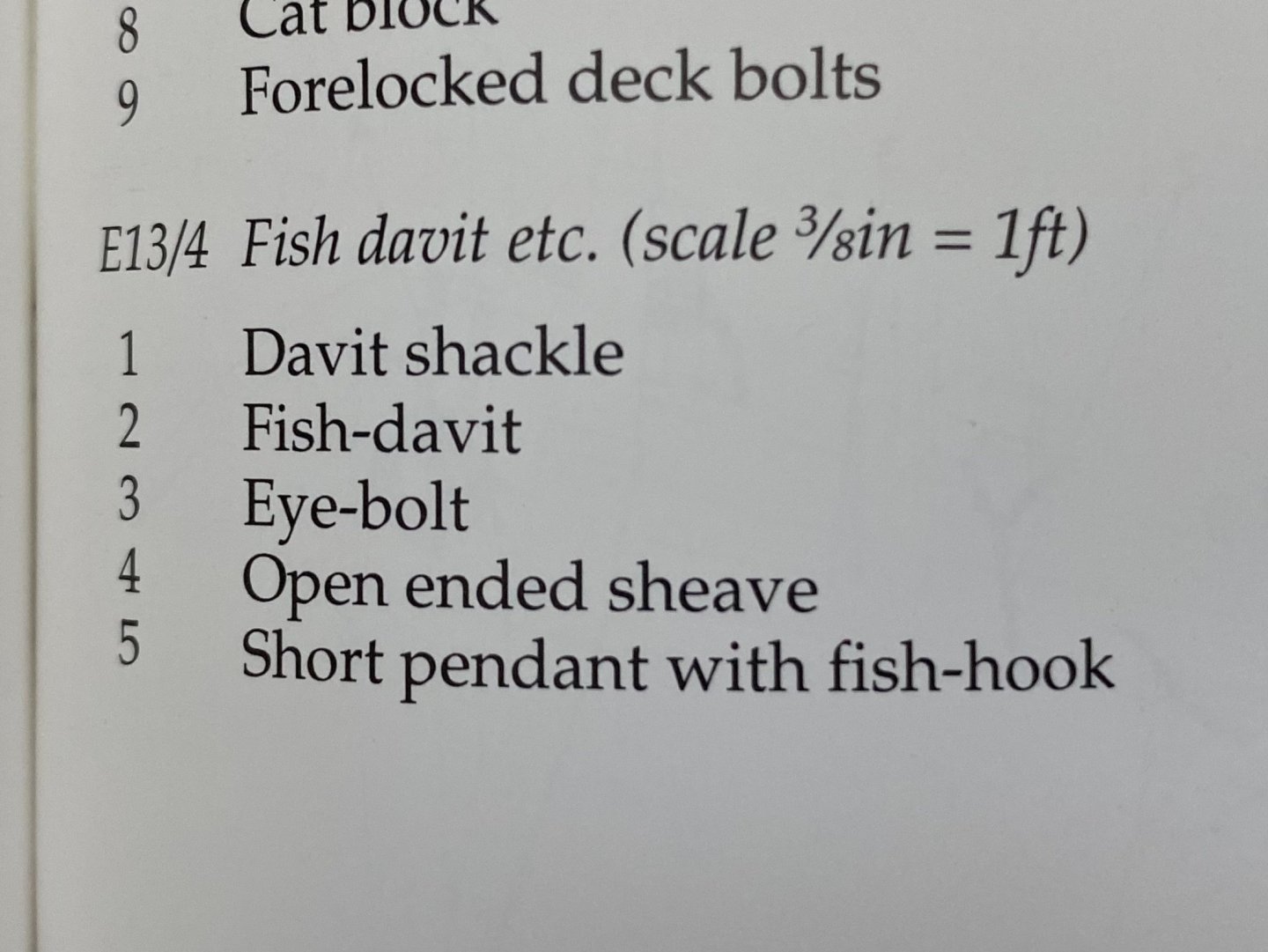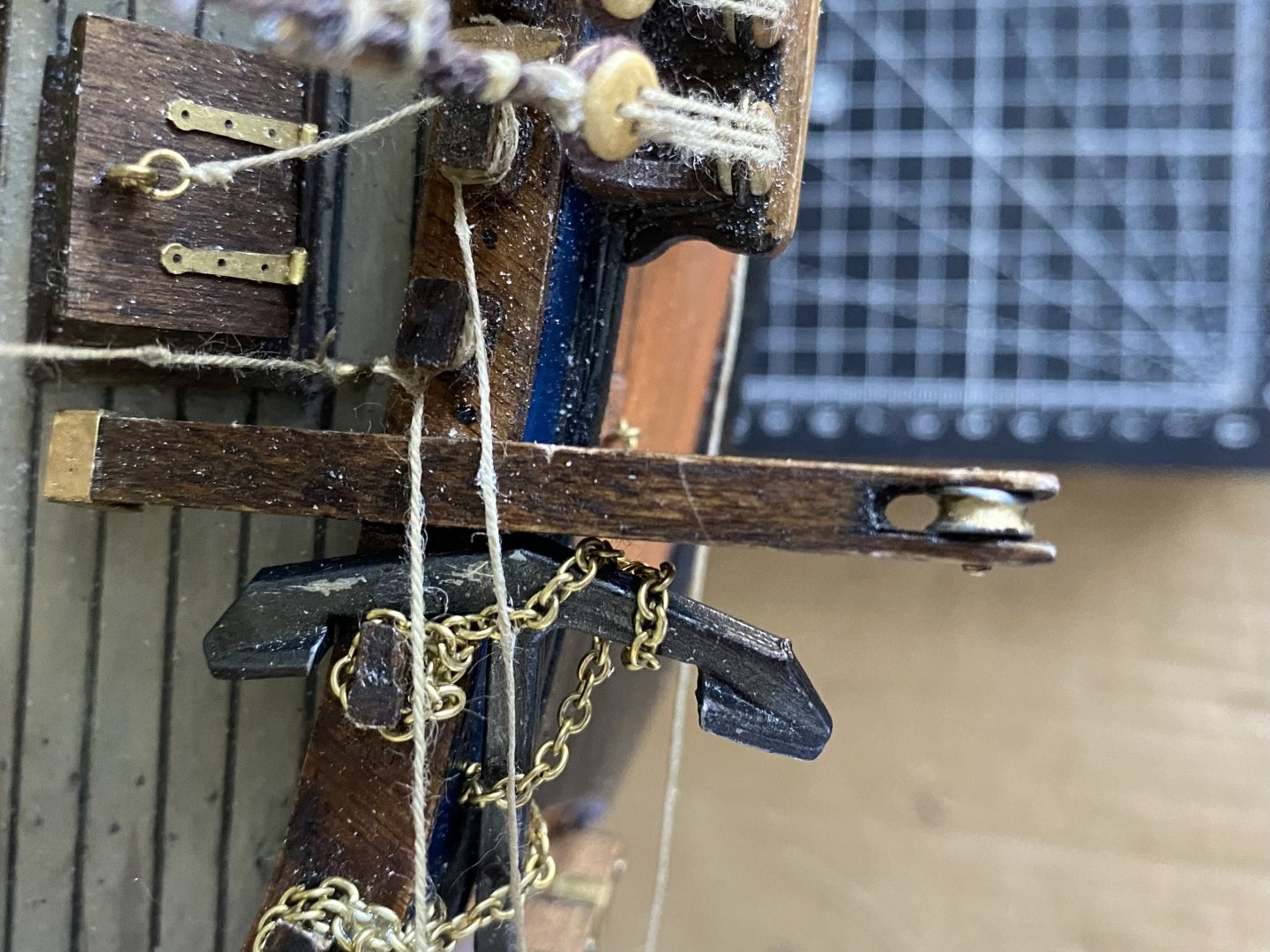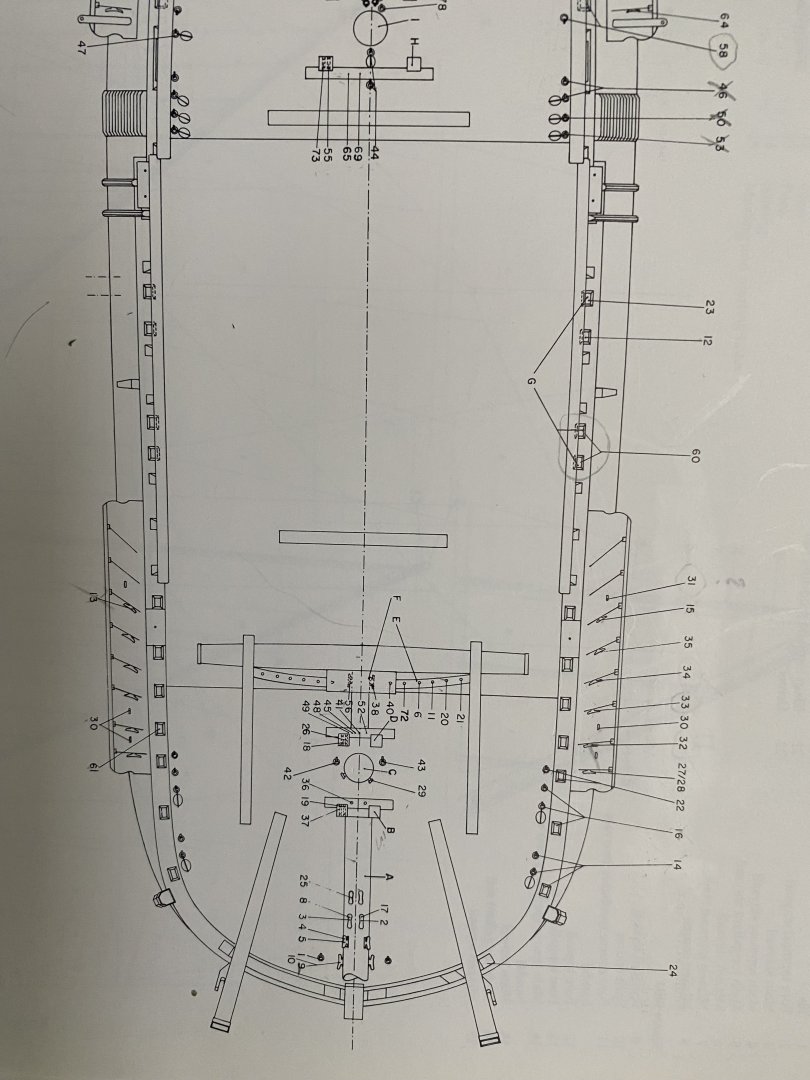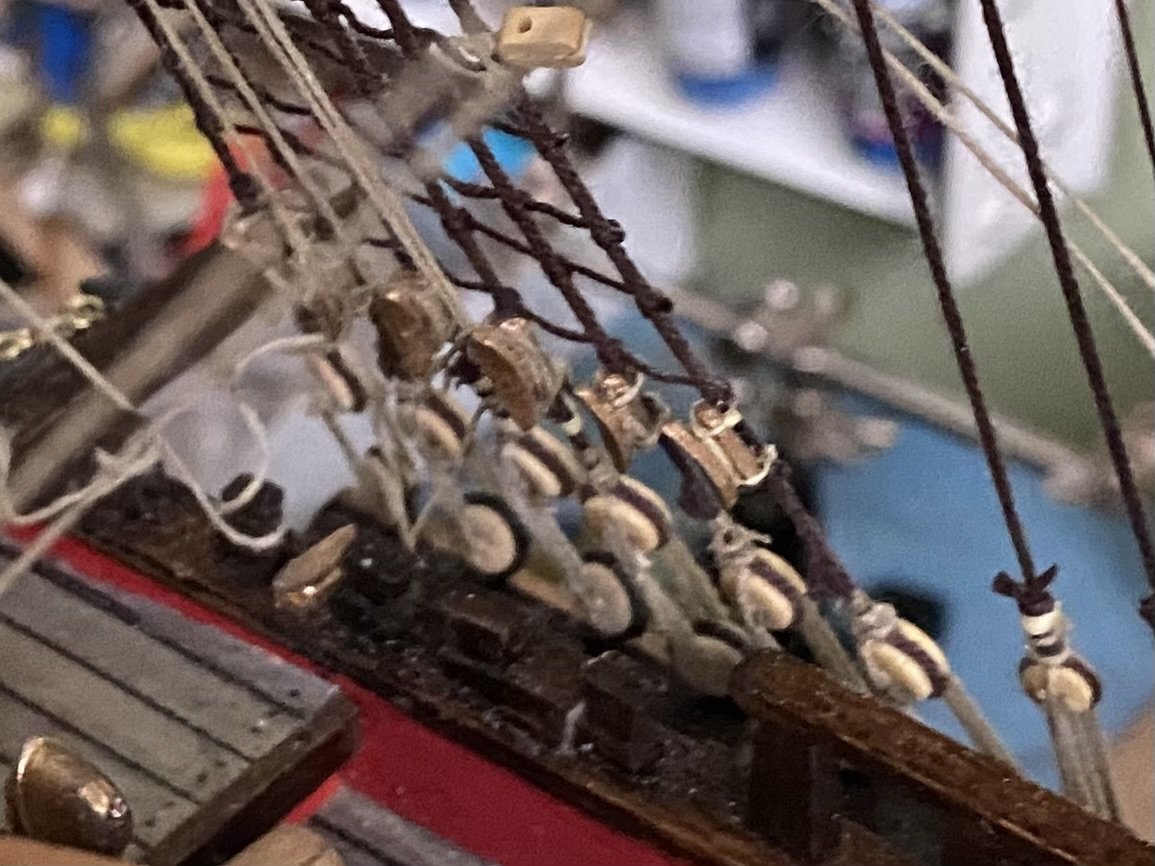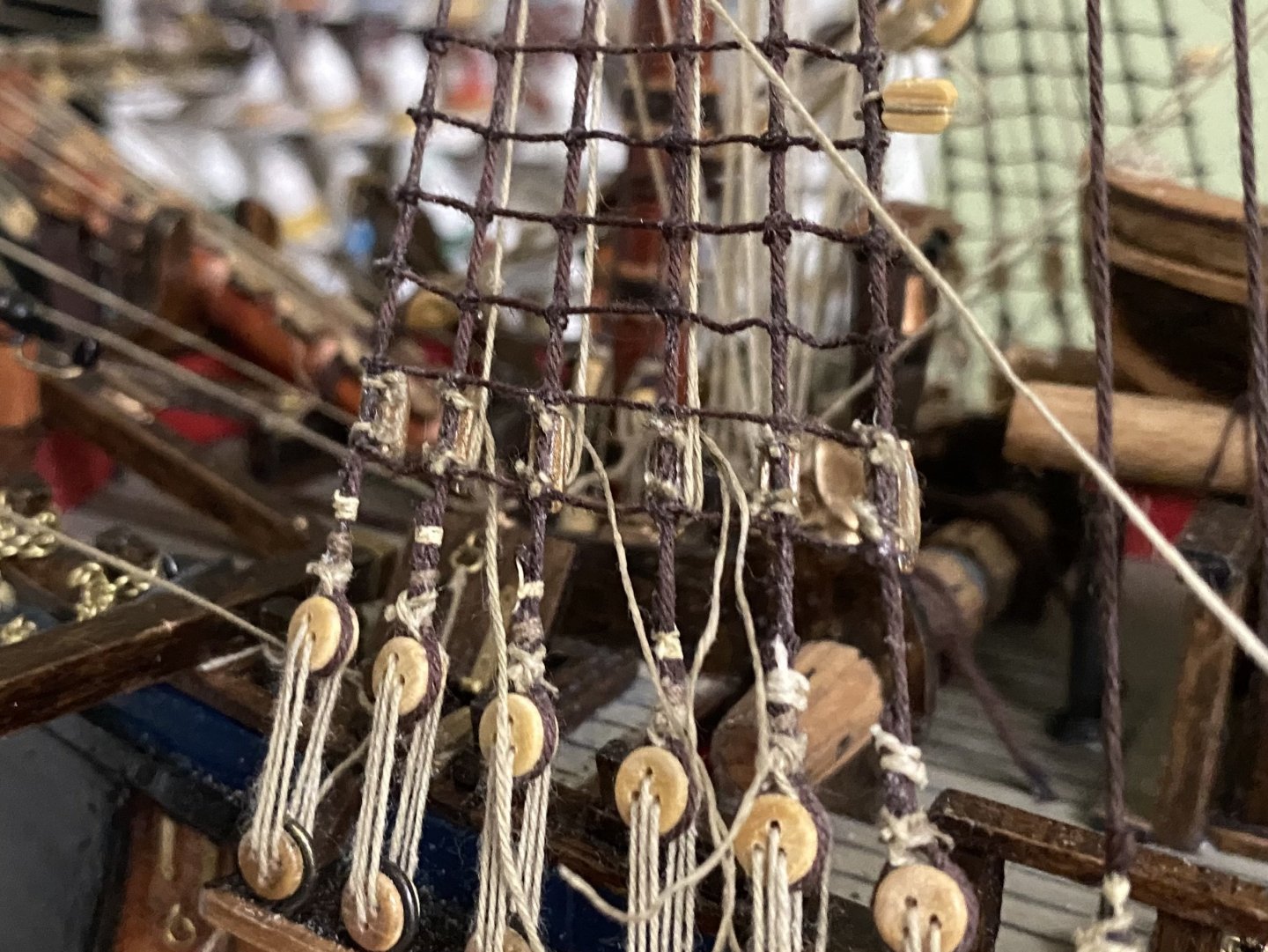
Bill97
Members-
Posts
2,721 -
Joined
-
Last visited
Content Type
Profiles
Forums
Gallery
Events
Everything posted by Bill97
-
Oh no Allan you did not hijack my post. I started the discussion and appreciated all the input. What I eventually did was keep the boomkins and simply ran guys back to the ship above the howser hole. Now no guys are below that point. I am not even going to question the outer gammoning! 😀
-
That does seem to be the most practical solution. I will give a look at removing the boomkins. If I can’t without to much damage I think i will arrange some sort of satisfactory rigging and call it a day on this riddle
-
Good morning Marc. Welcome to this very intriguing conversation. I always say when the world seems to be going to the dogs it is good to have a cave we can get in, roll the stone in front, and just talk ship building!😊
-
Steve where did you attach the tacks from the fore course sail if you didn’t have the boomkins? I am still open to making changes with the guy(s)/shrouds. Not going to remove the boomkins. That would make for a bunch of woodwork repair.
-
Gentlemen the fix is in. Moved both boomkin shrouds over to the knee. Also repositioned the cathead which makes the whole system work and look better. Now only thing remaining is deciding for sure where I want to reposition the fish davits. I currently have them where I left one end bolted to the deck by a ring bolt which permits rotating it inboard and outboard. I added an additional piece of wood where it would rest on the bulwark when in use. The additional oiece of wood is to protect the top of the bulwark. I currently rotated the davits forward and lay next to the cathead where I could lash them if I decide this is what I want.
-
Thanks guys. You have given me a path forward to solve this riddle. Will keep you informed. I think I will move the boomkins like the illustration above and also the shrouds as you show Allan. Wish me luck. Will require a bit of wood repair work but not to difficult. Bill
-
Thanks Trevor. I will give your suggestion a study to see how it might solve our riddle.
-
Allan this photo is from the same point of view as the one you posted of your build except mine is from the port side. I am trying to see what I have different from your’s that would solve the riddle. One thing I see is my rope from the anchor to the howser hole is shorter. Don’t know that would make a difference. think I am going to move further toward the stern of the ship working on rigging of the main mast while I continue to study and seek help on this bumpkin shroud/cathead anchor riddle. Surly someone out there has the answer. For now the bow of my model will just look in disarray. I could just say the heck with it and rig it as OcCre instructs (who would really know or care) but as we have discovered it would not be correct.
-
This is the drawing in the Anatomy of the Ship book by Marquardt. Showing the catheads inside the bumpkins. How would this have been possible for the anchor and rope not to have interfered with the bumpkin shrouds. Interesting
-
OK Trevor and Allan you guys have given me good advice s far. I tinkered with the anchor situation good part f the day and have some progress, but also a head scratcher. I attached a few photos. I think I can successfully move the fish davits inboard on the forecastle. The end is in a ring that pivots. I basically lifted loose end up and rotated it forward on the bow out of the way where I can lash it to a timber. In this configuration the crew could raise the loose end and pivot it back to the side to use. It is an idea. I also rigged the anchor to the cathead with a double block with a hook. My issue here that I need additional thought on is the cathead is right beside the bumpkin. The bumpkin shrouds go down to points on the hull. See red lines in photos. If the anchor would be pulled up to the side of the bow it comes in contact with the bumpkin shroud. What might I have wrong?
-
Thanks gentlemen. Sorry to have belabored such a small detail, but so appreciate your help. I am going to remove both fish davits, repair the area where it was, and find a convenient place to stow just one. Will show update when completed. Thanks again Bill
-
Ok great. My curiosity kenchington was, as you stated above, the fish davits were stowed away when not actually in use. alpayed I am leaving the anchors at the bow. So my question was once the anchors were raised with the help of the fish davits and fixed in position was the fish davit then stowed away? From what you guys are saying I think it was. So if I have my anchors on the bow then the fish davits should be stowed away not sticking out as mine are now. I need to remove them and stow on deck somewhere.
-
So Trevor I guess the easiest thing would be just to stow them on deck maybe. However I think I am confused. Are the fish davits just used to hoist the anchor and then stowed away once the anchor is locked in the weighed position or are they part of the weighed setup? Are they still helping to support the anchor the entire time it is secured on the side of the ship?
-
Thanks Trevor. So if I have my anchors weighed (is that the correct way to say it) I should have the fish tackle employed? I should rig the large hook into the ring of the anchor and then take the rope up to either the foremast or fore top mast head? I am assuming there would be the occasion where a rigging line would lay across the top of it as in my photo? The two lines are the spritsail clew (sail furled causes clew to be more inboard) and the fore course sail tack. Or I expect the tack may pass under it since it would be stationary unlike the spritsail clew that would move with the sail unfurled.
-
Hey Allan, or anyone who might know. How is this thing rigged? In the AOTS this is the only diagram and reference to it. The OcCre instructions only show how to make it and where ti put it. No explanation in either as to what it is and what it is used for. It is called a Fish Davit. It is constructed in such a way that it can pivot inboard or outboard as in the photo. I have it made and installed on my ship but don’t know for sure what to do with it now. My other ships have a pair of davits used for the boats that are stationary. On the Endeavour there is just this one on each side. I cannot find reference to show where the thimble in the end of line 5 (short pendant with fish-hook) goes.
-
Great job Marc on the coils. Always a pleasure just reading through your research and resulting build. Like yancovitch said, I am embarrassed to even post about my build. Maybe I should switch to macrame or jigsaw puzzles. 😊
- 2,699 replies
-
- heller
- soleil royal
-
(and 9 more)
Tagged with:
-
Spent some time adding cleats to the shrouds. OcCre has the lines going down to the center “thing”. AOTS has some of the rigging lines going to cleats attached to shrouds.
-
Furled , unfurled or no sails -Preference
Bill97 replied to Canada Steve's topic in Masting, rigging and sails
Very impressive Ab. I will definitely read through your tutorial. Glad to be on the receiving end of your advice. -
Furled , unfurled or no sails -Preference
Bill97 replied to Canada Steve's topic in Masting, rigging and sails
Did not know that Ab. That is fascinating. How are you able together the paint so nice. I thought they were wood. -
Furled , unfurled or no sails -Preference
Bill97 replied to Canada Steve's topic in Masting, rigging and sails
Ab are these photos of some of your builds? Absolutely beautiful! -
Furled , unfurled or no sails -Preference
Bill97 replied to Canada Steve's topic in Masting, rigging and sails
Thanks again Trevor. A lot of good information and advice. I know it is probably silly on my part but ever since I became a MSW member sharing my builds I try to be conscious of some accuracy. I envision posting photos of my build and a much more knowledgeable member saying t themselves “that is wrong, a ship would never be rigged like that”. Ian has been my go to for advice for several years. Appreciate all the help and advice you guys share. I know my furled sails need to have the “skin” pulled up tight over the cloth and I should adjust mine accordingly. By the way whenever I have a comment on my build from someone I had not seen before I like to check their profile to see where they live. Love your part of Canada. Been to Halifax a number of times. Especially like Peggy’s Cove. -
Thanks my friend. I am going with omit everything then. Just the sails I have furled to the yards. Still have to add the angled one on the back connected to the mizzen mast (forget right now what it is called).
About us
Modelshipworld - Advancing Ship Modeling through Research
SSL Secured
Your security is important for us so this Website is SSL-Secured
NRG Mailing Address
Nautical Research Guild
237 South Lincoln Street
Westmont IL, 60559-1917
Model Ship World ® and the MSW logo are Registered Trademarks, and belong to the Nautical Research Guild (United States Patent and Trademark Office: No. 6,929,264 & No. 6,929,274, registered Dec. 20, 2022)
Helpful Links
About the NRG
If you enjoy building ship models that are historically accurate as well as beautiful, then The Nautical Research Guild (NRG) is just right for you.
The Guild is a non-profit educational organization whose mission is to “Advance Ship Modeling Through Research”. We provide support to our members in their efforts to raise the quality of their model ships.
The Nautical Research Guild has published our world-renowned quarterly magazine, The Nautical Research Journal, since 1955. The pages of the Journal are full of articles by accomplished ship modelers who show you how they create those exquisite details on their models, and by maritime historians who show you the correct details to build. The Journal is available in both print and digital editions. Go to the NRG web site (www.thenrg.org) to download a complimentary digital copy of the Journal. The NRG also publishes plan sets, books and compilations of back issues of the Journal and the former Ships in Scale and Model Ship Builder magazines.

